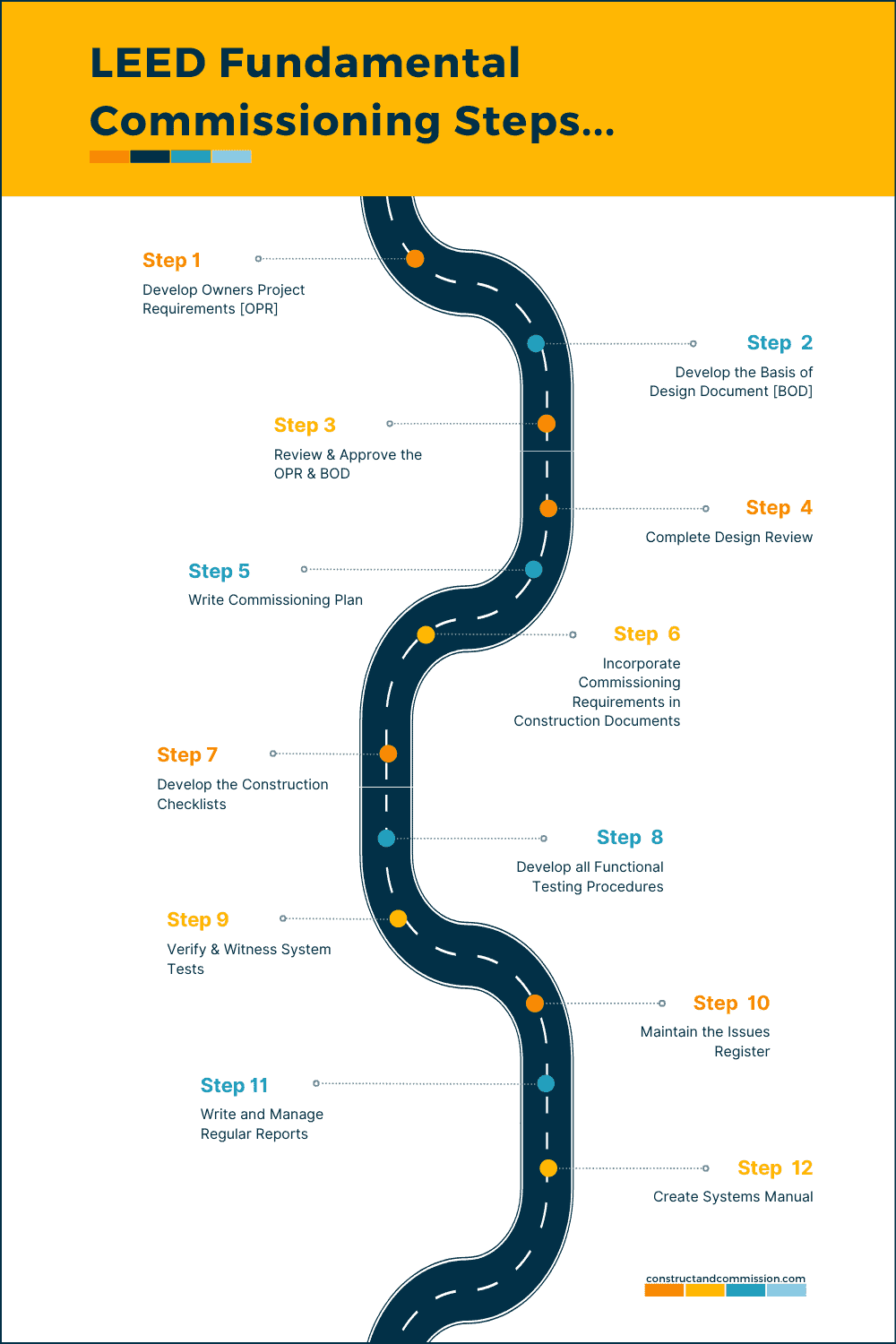LEED Fundamental Commissioning is a process completed under the U.S Green Building Council Pre-Requisite 1 EA Module, with its aim being that all fundamental systems relating to energy, water, indoor environmental quality, and durability, upon handover, have full documented proof that they are designed, installed, set up, and operating as per their original design intent.
The commissioning process should be based upon and follow the ASHRAE Guideline-0 and ASHRAE Guideline-1.1 documents.
To read more on LEED Enhanced Commissioning see our article 'Described + Tasks | LEED ENHANCED COMMISSIONING'
🟩 What is the purpose of the LEED Fundamental Process?
The purpose of the LEED Fundamental Commissioning Process is to ensure that during the construction process, the building’s equipment and systems are commissioning and setting up process-driven and methodical. Then, upon handover to the facilities team, the building’s systems are operating efficiently and fully in line with the previously agreed design requirements.
🟩 What systems are covered under fundamental commissioning?
Not all systems that are installed within the building are to be included in this delivery. Below are details of the systems covered:
- Renewable Energy Systems
- Domestic Hot Water Systems
- Lighting Controls
- Heating Systems
- Ventilating Sytems
- Air Conditioning Systems
- Refrigeration Systems
🟩 Who are the parties involved in and responsible for the fundamental commissioning process?
Whilst the complete construction project team has some form of input and responsibility to deliver the process, the overall responsibility to ensure it is done will usually fall to the client and independent commissioning agent [CxA].
🟩 When should the Commissioning Authority be employed?
The independent commissioning authority should be employed by the client no later than the design development phase of the project.
🟩 What is the selection procedure for employing a Commissioning Authority?
When employing the CxA the client should ensure that the company and engineers working on the project are experienced in delivering a full commissioning process.
There are certain requirements stated by LEED Fundamental, being:
- The CxA company and Engineers must be fully experienced with the Commissioning Process from the design stage to 10 months after occupancy. The experience should cover two projects with similar scope and size.
- The CxA can be one or all of the following:
- A qualified employee of the owner/building operator,
- An independent consultant,
- An employee of the design or construction company. but who is not part of the projects design or construction team,
- A disinterested contractor of the design or construction team.
- For projects smaller than 20,000 square feet [1,860 square meters], the CxA can be a qualified member of the design or construction team.

🟩 What steps need to be completed?
Between the client team and the commissioning agent [CxA], the following minimum tasks and activities should be completed to ensure that the fundamental commissioning process is delivered and adhered to:
🟧 Step 1 – Develop the Owners Project Requirement Document
Completed by the Client and CxA, the objective of the Owners Project Requirement Document or [OPR] is to provide the basis from which all design, construction, acceptance, and operational decisions are made, it should be agreed upon and in place prior to the Basis of Design Document [BOD] being written, Commissioning Plan and other Commissioning / Project Documents.
To read more on this see our article ‘OWNER’S PROJECT REQUIREMENT | [OPR] What is it?’
🟧 Step 2- Develop the Basis of Design Document
Sometimes referred to as the BOD and completed by the MEP Designer, it is a document created at the beginning of a project by the design team, to document that the projects concept, calculations, decisions, products, equipment, system selections, regulations, standards, codes, and guidelines meet the Owners Project Requirement Document [OPR].
To read more on this see our article ‘BASIS OF DESIGN | [BOD] How to Write’
🟧 Step 3 – Review and Approve the OPR & BOD
The commissioning agent [CxA] should ensure that the Owners Project Requirement and Basis of Design Document is reviewed and approved by the team.
🟧 Step 4 – Complete Design Review
The commissioning authority should ensure that the commissioning team completes a full review of the design to ensure that once the systems are built, they can be commissioned and set up in line with the design requirements.
🟧 Step 5 – Write the Commissioning Plan
The commissioning agent will write and issue the commissioning plan.
The purpose of this document is to clearly set out, to all parties, the commissioning process, activities, strategies, sequences, project schedules, documentation, and responsibilities for a project from the outset. It will usually be created and maintained/updated by the Commissioning Provider/Authority [CxP/CxA].
Once the Plan is issued, the project’s commissioning element will be managed quite effectively via clear goals and processes.
To read more on this see our article ‘COMMISSIONING PLAN | What is one and what to include’
🟧 Step 6 – Incorporate Commissioning Requirements into the Construction Documents
The commissioning agent should ensure that prior to the issue of the construction documents to the general/main contractor that they clearly convey the commissioning requirements.
The best way to do this would be to ensure the following are included:
- The Commissioning Plan,
- The Commissioning Specification,
- A clear understanding of the Commissioning Process from Pre-Design to Continuous Commissioning,
- A detailed Commissioning Process Flow Chart,
- Commissioning Activities and Task Responsibility Matrix,
- List of Systems and Equipment that should be Factory Tested,
- List of Systems and Equipment that should be Site Tested.
- Expectations to the Creating, Issuing, and Maintaining the Commissioning Documentation for Handover.
🟧 Step 7 – Develop the Construction Checklists
Part of the Commissioning Process as noted by ASHRAE Guideline 1.1, is for the project to create and complete 3 types of checklists throughout the activities:
- Pre-Design Checklists
- Design Checklists
- Construction Checklists.
To read more on these checklists, see our article ‘COMMISSIONING CHECKLISTS | the 3 types explained and listed’.
Within this article are examples of many construction checklists that can be used.
🟧 Step 8 – Develop and Manage all Functional Testing Procedures
The Commissioning Agent/Main/General Contractor should ensure all Functional Testing Procedures or Factory/Site Acceptance Method Statements are written and issued for review/approval when required in the relevant commissioning process step.
To understand more about this requirement see our article ‘HOW TO WRITE | A Method Statement’
🟧 Step 9 – Verify and Witness System Tests
Once all the relevant method statements and functional testing documents are approved, the Commissioning Agent should ensure that they verify that the testing has been conducted in line with the requirements.
Verification can be via 3 methods:
- Physical onsite verification as per the project sampling rates.
- Documentation review, after testing, has been completed.
- Hybrid of both, part physical and part documentation.
🟧 Step 10 – Maintain Issues Register
The CxA should ensure that all commissioning observations/issues are captured on an issues register and fully managed to completion/closeout prior to handover.
This register can also be a useful reference for the lessons learned document that would usually be produced and completed at the end of the building commissioning process.
🟧 Step 11 – Write and manage Weekly / Monthly / Final Reports
Weekly / Monthly Reports
To keep the client and project/construction team up to date throughout the project the CxA should write and issue regular commissioning reports.
It would usually be expected that in the early stages of the project, Monthly Reports would be issued. When the project commissioning activities get busier, a Weekly and Monthly Report will be issued.
Final Commissioning Report
will be written and issued by the commissioning agent [CxA] and is created to provide a full historical document of the commissioning process for any future reference needed for the building’s operation.
If you would like more information on this report, its format, and what should be included, see our article ‘COMMISSIONING REPORTS | Final Commissioning Report’
🟧 Step 12 – Create a Systems Manual
The commissioning authority should manage, write and issue a ‘Systems Manual’ that contains the information necessary to operate the building efficiently.
The manual should include the following:
- The sequence of operations and control logics for the building and its systems,
- The building occupancy schedule,
- All running equipment timers and schedules,
- Settings and setpoints for all HVAC equipment, include any differences between the seasons and days of the week.
- Lighting levels throughout the building;
- Minimum outside air requirements;
- A description of the mechanical and electrical systems and equipment within the building and how they operate;
- Include a preventive maintenance plan for building equipment,
- Periodic commissioning requirements include all expected ongoing commissioning tasks, continuous commissioning, and monitoring-based commissioning tasks for the facilities.
🟩 LEED Fundamental Document Downloads
If you would like a copy of our Open templates, they are available for purchase within our shop by clicking the buttons below.
🚀 The download includes the checklists for Enhanced Commissioning and Steps.
The Checklists are in MS Word, and the Steps are in PDF.
Based upon our article, FUNDAMENTAL & ENHANCED LEED COMMISSIONING High-Level Report/Checklist Template & Steps, in [Microsoft Word & PDF] format allowing editing and clean exporting for your full use.
🟩 LEED Fundamental High-Level Report/Checklist
🟩 LEED Fundamental Commissioning Road Map

⬛ Related Articles
COMMISSIONING DOCUMENTS | Listed including [PDF] Download
INSTALLATION vs. COMMISSIONING | A Quick Explanation…
4 DIFFERENT TYPES | of Building Commissioning
COMMISSIONING MEETINGS | Explanation and downloadable agenda
BUILDING COMMISSIONING | Why it’s Important & Benefits…
FREE SIGN-OFF CERTIFICATES | Level 0-6 Data Centre Commissioning + Download


![Fundamental & Enhanced LEED Commissioning High-Level Report/Checklist [MS Word]](https://constructandcommission.com/wp-content/uploads/2023/07/072-074.webp)